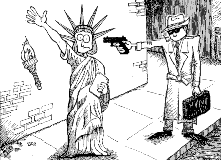ARGENTINA:
HOW DICTATORS FROM THE SOA
"DISAPPEAR" HUMANS AND THEIR RIGHTS

(1) Two graduates of the SOA become bloody dictators after a military coup overthrows a freely (and repeatedly) elected government.
(2) Their torture and killing include methods beyond even the Nazi imagination. Later, they forcibly demand, and receive, amnesty.
The gory details …
After World War II, populist leader Juan Perón rules Argentina as an elected president for a decade. In 1955, however, he is overthrown in a military coup. Civilian governments are prevented from completing their terms in office by military coups in 1966 and 1973.
"[A]s many people will die in Argentina as is necessary to restore order." — Army Commander-in-Chief Jorge Rafael Videla, 10/75, who becomes president five months later after overthrowing the civilian government.
What is the feared "disorder"? A diagram used at Argentina’s Air Force Academy depicts a tree of subversion with three roots: Marxism, Zionism, and Freemasonry. Progressive Catholicism appears at the top, and new growths at the bottom include human rights organizations, women’s rights, pacifism, nonaggression, disarmament, the Rotary Club, Lions Club, and junior chambers of commerce. The main branches off the trunk are Communist parties, the extreme totalitarian right (nazism and fascism), Socialist parties, liberal democracy, revolutionary front parties, Protestants, sectarians and anti-Christians, armed revolutionary organizations, and "indirect aggression"--branches off this last limb are: drug addiction, alcoholism, prostitution, gambling, political liberalism, economic liberalism, lay education, trade union corruption, "hippiness", pornography, homosexuality, divorce, art, newspapers, television, cinema, theater, magazines, and books.
"First we will kill all the subversives; then we will kill their collaborators; then … their sympathizers; then … those who remain indifferent; and finally we will kill the timid." -- General Iberico Saint Jean, military governor of Buenos Aires, 5/76
Under this paranoid vision, the military wages the "Dirty War" of torture, terror, and "disappearances" against the people of Argentina. Most of their victims have no connection at all to armed guerillas, but are considered guilty because of their "dangerous" political views. As many as half of the disappeared are labor activists. – Jack Donnelly, International Human Rights
Two of the military dictators overseeing this war, Roberto Viola and Leopoldo Galtieri, are graduates of the School of the Americas. Under Galtieri alone, thirty thousand people are killed or disappeared.
Examples of torture …
The Navy Mechanics School (ESMA) in Buenos Aires was Argentina’s most important clandestine detention and torture center (of 340 documented centers). Torture at ESMA became virtually a routinized, bureaucratic activity. A trip to ESMA typically began with "Caroline", a thick broom handle with two long wires running out the end. The victim was stripped and tied to a steel bed frame. Electricity was applied to the victim, who often was periodically doused with water to increase the effects.
It was unhurried and methodical. If the victim was a woman they went for the breasts, vagina, anus. If a man, they favored genitals, tongue, neck. … Sometimes victims twitched so uncontrollably that they shattered their own arms and legs. Patrick Rice, an Irish priest who had worked in the slums and was detained for several days, recalls watching his flesh sizzle. What he most remembers is the smell. It was like bacon. – Ian Guest, Behind the Disappearances
Children were tortured in front of their parents, and parents in front of their children. One torturer estimates that about 60 babies passed through ESMA, and that all but 2—whose heads had been smashed against the wall in efforts to get their mothers to talk—were sold (John Simpson and Jana Bennett, The Disappeared). And the torture continued for days, weeks, even months, until the victim was released or, more often, killed.
The sadistic brutality did not always even end with the death of the victim. "One woman was sent the hands of her daughter in a shoe box." The body of another young woman "was dumped in her parents’ yard, naked but showing no outward signs of torture. Later the director of the funeral home called to inform her parents that the girl’s vagina had been sewn up. Inside he had found a rat." – V.S. Naipaul, The Return of Evan Perón
Most bodies, however, were never recovered. At ESMA, which also served as a disposal site for other naval camps, corpses were initially buried under the sports field. When this was filled, the bodies were burned daily, at 5:30 in the afternoon, usually after having been cut up with a circular saw. Finally, those in charge of destroying the evidence of their crimes hit on the idea of aerial disposal at sea. Once they mastered the currents—at first bodies washed up in Buenos Aires, then at Montevideo—there was no trace to be found. Other units encased their bodies in cement and dumped them in the river. The army’s preferred method seems to have been to drive the corpses to the cemetary and register them as "NN", Name Unknown.
The Dirty War came to an official end after the Argentine military’s embarrassing failure to reconquer the Malvinas (Falkland Islands) from the British. Two weeks before the election in 1983 that brought a return to civilian rule, the Argentine junta issued a Law of National Reconciliation that created a blanket amnesty for all offenses connected with the "war against subversion". Although a few top military leaders were prosecuted, after several military uprisings the civilian government grants pardons to all in 1990.